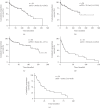Clinical Presentation, Natural History, and Therapeutic Approach in Patients with Solitary Fibrous Tumor: A Retrospective Analysis
- PMID: 32300277
- PMCID: PMC7140119
- DOI: 10.1155/2020/1385978
Clinical Presentation, Natural History, and Therapeutic Approach in Patients with Solitary Fibrous Tumor: A Retrospective Analysis
Erratum in
-
Corrigendum to "Clinical Presentation, Natural History, and Therapeutic Approach in Patients with Solitary Fibrous Tumor: A Retrospective Analysis".Sarcoma. 2021 Jan 29;2021:4653987. doi: 10.1155/2021/4653987. eCollection 2021. Sarcoma. 2021. PMID: 33628084 Free PMC article.
Abstract
Background: Solitary fibrous tumor (SFT) is a rare variant of soft tissue sarcoma (STS). Materials and Methods. We reviewed SFT patients (pts) treated at our institution between 12/1990 and 09/2017.
Results: We identified 94 pts with a median follow-up (mFU) of 4.7 years (range: 0.1-21.53). Primary sites were the chest (33%), abdomen (21.3%), brain (12.8%), and extremities (9.6%); 6.4% of pts presented with synchronous metastasis. Median overall survival (mOS) from the first diagnosis was 56.0 months (m) (0.3-258.3). Doege-Potter syndrome was seen in 2.1% of pts. Primary resection was performed in 86 pts (91.5%). Median progression-free survival was 34.1 m (1.0-157.1), and 43% of pts stayed SFT-free during FU. Local recurrence occurred in 26.7% after a mFU of 35.5 m (1.0-153.8), associated with an OS of 45.1 m (4.7-118.2). Metachronous metastasis occurred in 30.2% after a mFU of 36.0 m (0.1-157.1). OS in metastatic pts was 19.0 m (0.3-149.0). Systemic therapy was given to 26 pts (27.7%) with inoperable/metastatic disease. The most common (57.7%) upfront therapy was doxorubicin, achieving responses in 13.3% of pts with a PFS of 4.8 m (0.4-23.8). In second line, pts were treated with ifosfamide or pazopanib, the latter achieving the highest response rates. Third-line treatment was heterogeneous.
Conclusion: SFT is an orphan malignancy with a highly variable clinical course and a considerable risk of local failure and metachronous metastasis. Surgery is the only curative option; palliative systemic therapy is used in inoperable/metastatic cases but achieves low response rates. The highest response rates are seen with pazopanib in second/third line.
Copyright © 2020 P. Schöffski et al.
Conflict of interest statement
The authors declare that there are no conflicts of interest regarding the publication of this paper.
Figures




References
LinkOut - more resources
Full Text Sources

